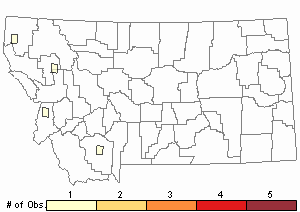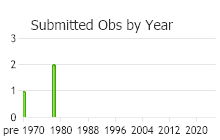View in other NatureServe Network Field Guides
NatureServe
Montana
Utah
Wyoming
Idaho
Wisconsin
British Columbia
South Carolina
Yukon
California
New York
Windblown Squirrel-tail Moss - Sciuro-hypnum plumosum
Other Names:
Brachythecium plumosum
General Description
Plants: Pleurocarpous (Vitt 1988). Growing in open to crowded, erect clumps (FNA 2014) or mats (Lawton 1971), dark green, ochre with red tinges, occasionally various leaves of a plant dotted with rust-colored spots. Stems prostrate, straight or a little bowed, appearing with the leaves circular in X-section, up to 5 cm in length; possessing a central strand. Branches up to 6 mm in length (FNA 2014).
Stem Leaves: Spreading somewhat when moist, flat against the stem and somewhat to considerably overlapping when dry (Lawton 1971), egg-shaped, sometimes tending toward lance-shaped, 1.4-2 mm in length, 0.4-1 mm in width, not pleated (FNA 2014) or minutely so, deeply cupped (Lawton 1971); margins finely saw-toothed, flat or curved back and downward proximally; base extending along the stem a little; apex with a short acumen; costa 1/3 to 2/3 the length of the leaf; widest near the base, quickly becoming more slender in the lower 1/3 of the leaf, the dorsal spine lacking or minute (FNA 2014).
Branch Leaves: Smaller and more slender than the stem leaves; margins less finely saw-toothed (FNA 2014).
Leaf Cells: Alar cells nearly square (Lawton 1971) with medium-thick walls, the cells next to the costa about the same size or a little smaller, the alar area opaque (FNA 2014); basal cells wider and not as long as the median cells (Lawton 1971), arranged in 3-7 tiers crosswise to the base, the area opaque (FNA 2014); upper cells long and narrow (Crum and Anderson et al. 1981).
Diagnostic Characteristics
Northern plants growing on rock in mostly wet conditions occasionally have very curved leaf apices whereas southern plants in drier habitats are straight and slenderer. The rusty-red spots and the opaque cells extending across the bottom are distinctive. The occasional opacity of the leaf corners of Sciuro-hypnum oedipodium does not extend across the base (FNA 2014).
Sciuro-hypnum populeum also has short, rather even cells across the base; however, the costa is percurrent or nearly so (over 4/5 the leaf length). That of S. plumosum is shorter (FNA 2014).
Range Comments
North American Range
Canada: NT, BC, MB and ON, NB, NL, and NS; USA: Found in most states except UT, NV and from ND to TX (FNA 2014). Known in Montana from Lake, Lincoln, Madison, and Ravalli Counties (Elliott 2016).
Observations in Montana Natural Heritage Program Database
Number of Observations: 4
(Click on the following maps and charts to see full sized version)
Map Help and Descriptions
Relative Density

Recency


 (Observations spanning multiple months or years are excluded from time charts)
(Observations spanning multiple months or years are excluded from time charts)
Habitat
Bark on tree bases, shaded rocky bluffs and outcrops (FNA 2014), wet rock in streams and on cliffs (Elliott 2016). Elevation: 0-10,170 feet (FNA 2014).
Reproductive Characteristics
Autoicous. Perichaetial leaves enveloping the stem proximally, the apices spreading (Lawton 1971). Seta 1.2-2.4 cm tall, red, papillae-roughened (occasionally faintly so). Capsule 1.3-2 mm in length, ascending somewhat, rounded a little more on the upper side than the bottom, red (FNA 2014) or deep brown; cilia knobby or with crosswise projections (Lawton 1971).
References
- Literature Cited AboveLegend:
 View Online Publication
View Online Publication Crum, H.A. and L.E. Anderson. 1981. Mosses of Eastern North America. 2 volumes. Columbia University Press, New York. 1328 pp.
Crum, H.A. and L.E. Anderson. 1981. Mosses of Eastern North America. 2 volumes. Columbia University Press, New York. 1328 pp. Elliott, J.C. and A.K. Pipp. 2018. A Checklist of Montana Mosses (1880-2018). Updated 3 January, 2020. Montana Natural Heritage Program, Helena, Montana. 73 pp.
Elliott, J.C. and A.K. Pipp. 2018. A Checklist of Montana Mosses (1880-2018). Updated 3 January, 2020. Montana Natural Heritage Program, Helena, Montana. 73 pp. Flora of North America Editorial Committee, eds. 2014. Flora of North America North of Mexico. Volume 28. Bryophytes: Mosses, Part 2. Oxford University Press, Inc., NY. xxi + 702 pp.
Flora of North America Editorial Committee, eds. 2014. Flora of North America North of Mexico. Volume 28. Bryophytes: Mosses, Part 2. Oxford University Press, Inc., NY. xxi + 702 pp. Lawton, E. 1971. Moss Flora of the Pacific Northwest. Hattori Botanical Laboratory. Japan: Yamabuki-cho, Shinjuku-ku, Tokyo. 362 pages plus appendices.
Lawton, E. 1971. Moss Flora of the Pacific Northwest. Hattori Botanical Laboratory. Japan: Yamabuki-cho, Shinjuku-ku, Tokyo. 362 pages plus appendices. Vitt, D. J. Marsh, and R. Bovey. 1988. Mosses, Lichens & Ferns of Northwest North America. Seattle, WA: University of Washington Press. 296 p.
Vitt, D. J. Marsh, and R. Bovey. 1988. Mosses, Lichens & Ferns of Northwest North America. Seattle, WA: University of Washington Press. 296 p.
- Additional ReferencesLegend:
 View Online Publication
View Online Publication
Do you know of a citation we're missing? Elliot, J. C. 1993. Second checklist of Montana mosses. Unpublished report. U.S. Forest Service, Region 1. Missoula, MT. 45 pp.
Elliot, J. C. 1993. Second checklist of Montana mosses. Unpublished report. U.S. Forest Service, Region 1. Missoula, MT. 45 pp. Lawton, E. 1971. Keys for the Identification of the Mosses on the Pacific Northwest. Reprinted from 'Moss Flora of the Pacific Northwest'. Published as Supplement No. 2 of the Journal of the Hattori Botanical Laboratory. Nichinan, Miyazaki, Japan. 66 pp.
Lawton, E. 1971. Keys for the Identification of the Mosses on the Pacific Northwest. Reprinted from 'Moss Flora of the Pacific Northwest'. Published as Supplement No. 2 of the Journal of the Hattori Botanical Laboratory. Nichinan, Miyazaki, Japan. 66 pp. Smith, A.J.E. 1980. The Moss Flora of Britain and Ireland. Cambridge University Press, Cambridge. 705 pp.
Smith, A.J.E. 1980. The Moss Flora of Britain and Ireland. Cambridge University Press, Cambridge. 705 pp.
- Web Search Engines for Articles on "Windblown Squirrel-tail Moss"





